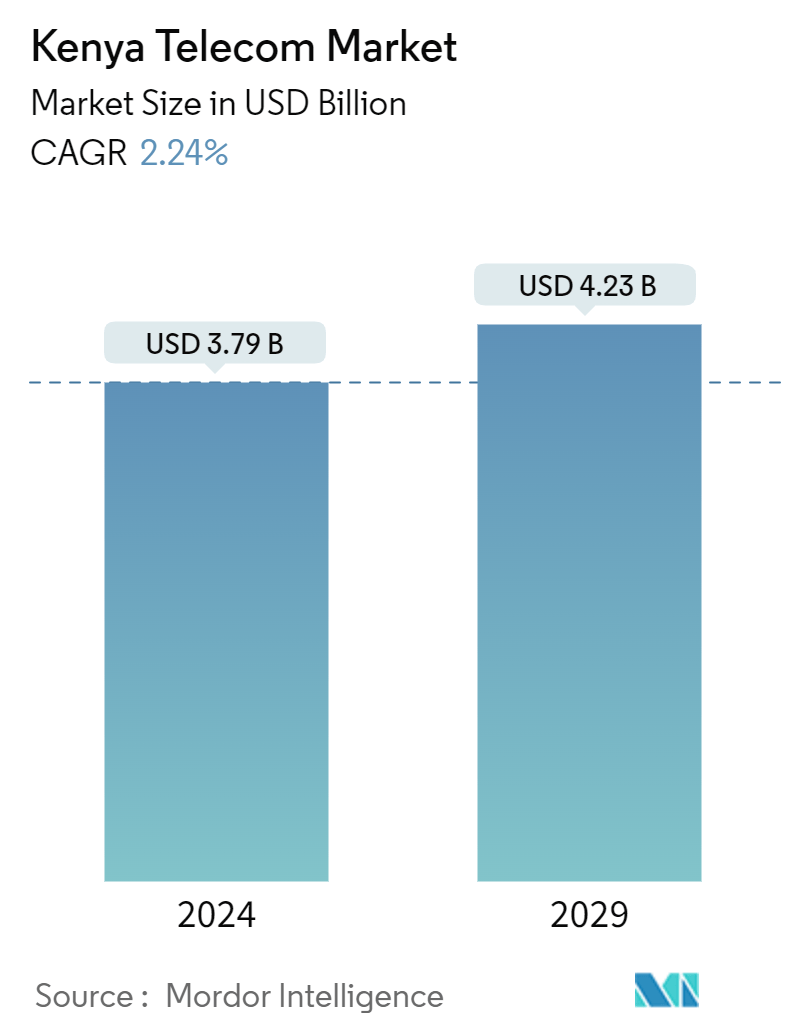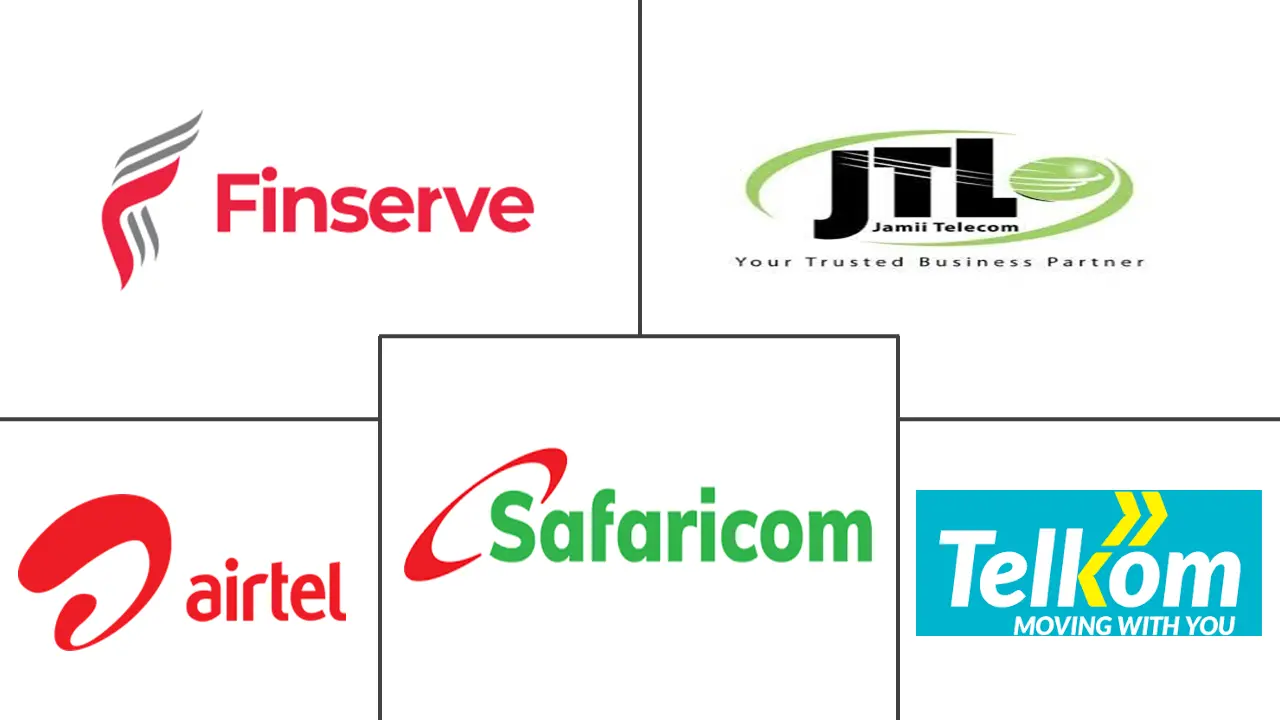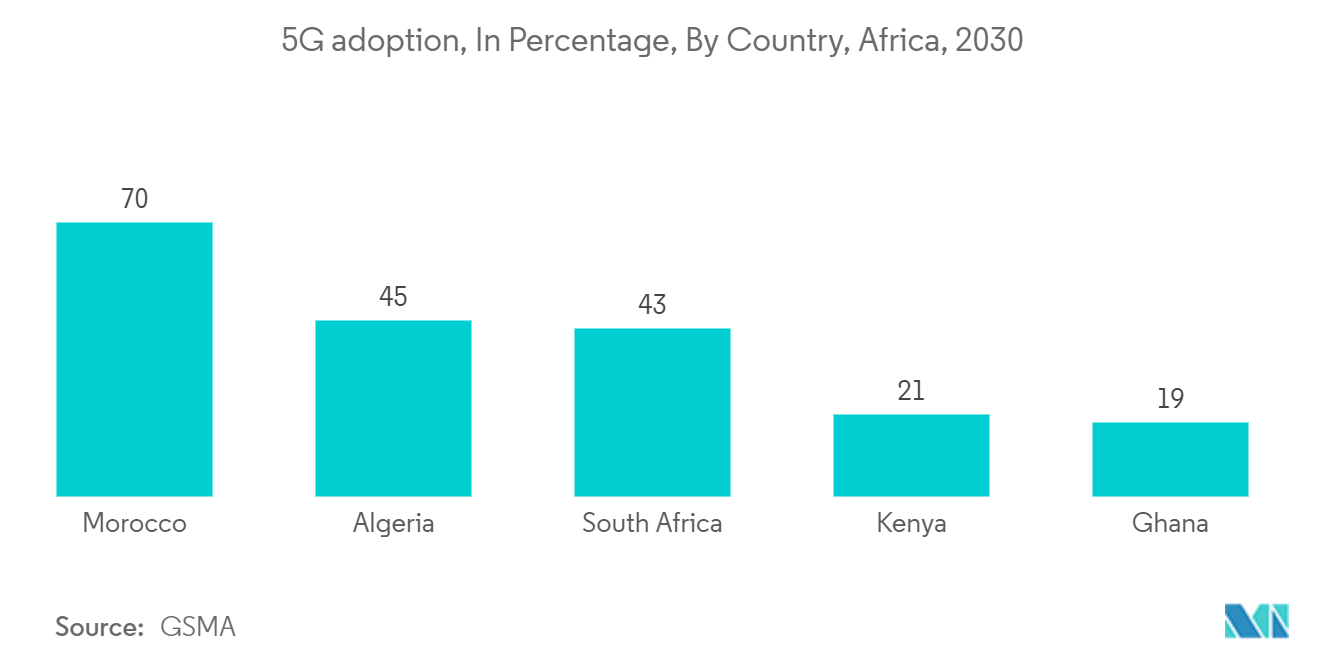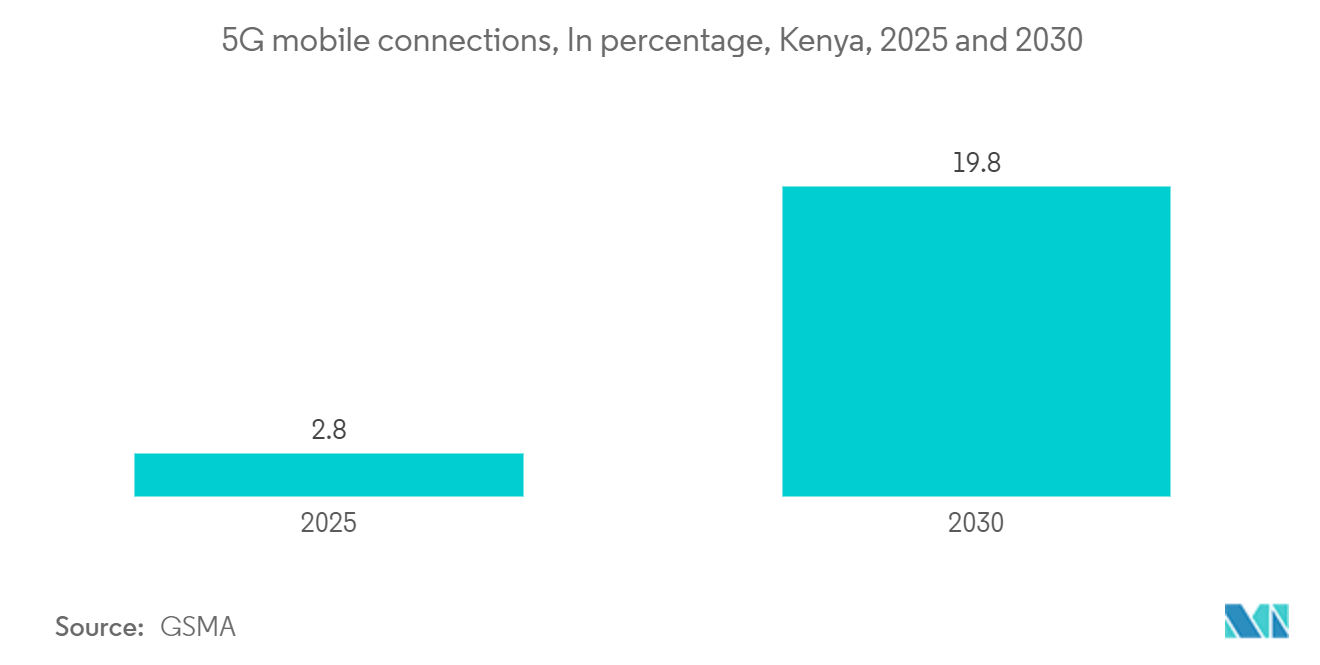Kenya Telecom Market Size

| Study Period | 2019 - 2029 |
| Base Year For Estimation | 2023 |
| Market Size (2024) | USD 3.79 Billion |
| Market Size (2029) | USD 4.23 Billion |
| CAGR (2024 - 2029) | 2.24 % |
| Market Concentration | Medium |
Major Players
*Disclaimer: Major Players sorted in no particular order |
Kenya Telecom Market Analysis
The Kenya Telecom Market size is estimated at USD 3.79 billion in 2024, and is expected to reach USD 4.23 billion by 2029, growing at a CAGR of 2.24% during the forecast period (2024-2029).
- Kenya's telecommunications sector is propelled by the increasing demand for mobile voice, data, and internet services. This increase is primarily fueled by a growing urban population and the widespread adoption of mobile phones that support 3G, 4G, and even 5G services in Kenya. Moreover, the country is a pioneer in money with services such as M-Pesa, which allows the market players to invest in innovation and growth, such as expanding financial inclusion and integrating mobile money with other services.
- Increased investments in 4G infrastructure have bolstered service quality and expanded its coverage. The rollout of 5G is planned to revolutionize connectivity, enabling a host of new applications, notably in the realm of IoT. In July 2023, Safaricom, a prominent Kenyan telecommunications company, partnered with AST SpaceMobile. Their collaboration aims to introduce a satellite internet service. Leveraging AST SpaceMobile's technology, this service will enhance broadband offerings, including Wi-Fi, cellular networks, and fiber optic cables, particularly targeting remote and rural areas.
- The high cost of deploying and maintaining telecom infrastructure, especially in remote and rural areas, is a barrier to market growth. The cost involved in laying fiber optic cables, setting up mobile towers, and acquiring spectrum licenses limits small players from expanding their networks and services.
- Post-COVID-19, companies experienced business transformation. Companies and individuals made investments in digital tools and services, including cloud computing, cybersecurity solutions, and e-commerce platforms. The government and regulatory bodies introduced supportive services for better connectivity, driving market growth.
- M-Pesa, the mobile money service, has grown significantly, catering to over 51 million customers in seven African nations. Notably, in partnership with Vodafone's Kenyan affiliate, Safaricom, M-Pesa expanded its mobile money services to Ethiopia, the continent's second most populous nation. Additionally, merchant payments and e-commerce activities are emerging as key drivers of this growth. As Vodaphone's clients increasingly embrace digital platforms, the companies are committed to offering them a seamless ecosystem for digital transactions, accessible through USSD or the M-Pesa Super App.
Kenya Telecom Market Trends
The Demand for 4G and 5G Services is Rising
- Many market players are investing in building a 5G infrastructure. For instance, Safaricom rolled out its 5G services in Kenya in October 2022, starting with 35 active sites in key cities like Kisumu, Nairobi, and Mombasa, as well as Kisii and Kakamega. Safaricom rolled out 5G services in 11 Kenyan towns, a number that surged to 28 by April 2023. The company had planned to boost its 5G sites from 205 to an ambitious 800 by March 2024. Safaricom's strategic focus is to emphasize 5G primarily for fixed Wi-Fi services, targeting homes and offices with the highest demand.
- Kenya has seen a notable surge in digital adoption, reshaping governmental and business operations and redefining citizen interactions with services. The Kenyan government aims to enhance service delivery, transparency, and overall efficiency by prioritizing digital adoption. 5G facilitates fast speeds, with download speeds reaching up to 1 Gbps, which means it outperforms its predecessors, 4G and 3G, by a considerable margin, helping perform tasks efficiently.
- Streaming devices for movies, TV shows, and music are also growing. Many platforms, such as Netflix and Spotify, require high-speed Internet for seamless user experiences, driving the market for 4G and 5G services. Additionally, there is a growing potential to capitalize on digital gaming, especially for cloud-based gaming services, which demand high-speed connectivity and minimal latencies. As per data by GSMA, the adoption of 5G in Kenya is expected to account for 21% of total connections by 2030.
- Moreover, consumers are demanding service quality and higher speeds for their internet usage. This demand is pushing telecom providers to enhance network capabilities with 4G and 5G technologies. Consumers require faster Internet for online transactions, streaming, and remote work.

Data and Messaging Services are Expected To Witness Market Growth
- The penetration of affordable smartphones is growing, which has enhanced mobile data usage. Most people in Kenya use mobile devices to access the Internet, driving data consumption. Investments in 4G networks and rollouts of 5G connectivity are accelerating internet speeds, further encouraging more data usage.
- Nairobi is Kenya's epicenter for data center growth and foreign investments, with other cities transitioning toward similar trajectories. In August 2023, IXAfrica Data Centre Limited, a key player in hyperscale-ready data centers in East Africa, partnered with Tilisi Developments PLC, a prominent real estate developer. Together, they announced that IXAfrica inked a term sheet to acquire 11 acres of prime Nairobi land from Tilisi as its second data center campus. This move signified a significant milestone for both entities and underlined a substantial stride in bolstering East Africa's data infrastructure.
- The growth of online shopping and mobile money services like M-Pesa has increased data traffic. Many market players are expanding their services for revenue growth. For instance, in March 2024, Coronation Group, Access Holdings PLC, Safaricom PLC, and M-PESA Africa joined forces in a strategic alliance. This alliance planned to enhance African remittance access, fostering financial inclusion and economic growth. Specifically, they plan to establish a remittance corridor linking East and West Africa, bridging major economies on the continent.
- Kenya is in the nascent stages of 5G adoption. The primary hurdle lies in the patchy network coverage, making it a luxury for most users. Additionally, the mobile devices and routers that work with them are quite expensive for the average Kenyan consumer or business, which creates an opportunity for market players to develop affordable solutions. To bridge this gap, Kenya must not only expand and democratize its 5G networks but also strive to make the associated devices more cost-effective.
- The growth of e-commerce platforms such as Jumia and Kalimall is increasing the need for reliable internet connections. Promoting online shopping and digital marketplaces is also driving usage. Generally, people in Kenya use mobile phones for data usage. According to GSMA data, Kenya's 5G mobile connection is expected to reach 2.8 million by 2025.

Kenya Telecom Industry Overview
The Kenyan telecom market is semi-consolidated and includes major players such as Telkom Kenya, Safaricom PLC, Airtel Kenya Ltd, Finserve Africa Limited (Equitel), and Jamii Telecommunications Limited (Faiba).
Vendors operating in the market are expected to focus their strategic efforts on investments in partnerships and alliances. In addition, they are expanding their presence to gain new customers. The firm concentration ratio is high, and all major players are working toward achieving a better share, increasing competitive rivalry.
February 2024: Equitel, a prominent mobile virtual network operator, joined forces with Airtel to unveil 5G services in Kenya, marking a significant leap in service offerings. This strategic partnership positions Equitel as the pioneer MVNO in Africa to introduce 5G services. The expansive network is set to cover 370 key locations, spanning from Mombasa and Nairobi to Athi River, Kisumu, and beyond.
November 2023: Safaricom, a Kenyan operator, alongside M-Pesa Africa, its mobile financial service arm, and Sumitomo Corporation, a global trading and investment entity, announced the launch of the Spark Accelerator. This program is specifically designed to bolster early-stage start-ups in Kenya, aiding them in expanding and reaching new heights. Together, these partners committed to a collaborative effort, focusing on scouting promising start-ups and offering a comprehensive package of mentorship, funding, and go-to-market assistance.
Kenya Telecom Market Leaders
-
Telkom Kenya
-
Safaricom PLC
-
Airtel Kenya Ltd
-
Finserve Africa Limited (Equitel)
-
Jamii Telecommunications Limited (Faiba)
*Disclaimer: Major Players sorted in no particular order
.webp)
Kenya Telecom Market News
- October 2024: Safaricom has expanded its M-PESA Global service to include Ethiopia, enabling users to transfer mobile money from Kenya to Ethiopia. With this growth, the two companies strive to enhance the utilization and reach of mobile money in Ethiopia, which can help stimulate local economies and provide new prospects for people and businesses in the area. This partnership reflects our dedication to providing creative financial options that meet the changing demands of our clients.
- September 2024: Axian Telecom was reportedly looking to acquire Kenya-based mobile, internet and TV provider Wananchi Group. The Standard reported according to files made with regulator Comesa Competition Commission, Axian Telecom subsidiary Axian Telecom Fibre is looking to acquire 99.63% of Wananchi. It trades under the Zuku brand offering TV, broadband and mobile across Kenya, Tanzania, Uganda, Malawi and Zambia.
Kenya Telecom Market Report - Table of Contents
1. INTRODUCTION
1.1 Study Assumptions and Market Definitions
1.2 Scope of the Study
2. RESEARCH METHODOLOGY
3. EXECUTIVE SUMMARY
4. MARKET INSIGHTS
4.1 Market Overview
4.2 Industry Ecosystem Analysis
4.3 Industry Attractiveness- Porter's Five Force Analysis
4.3.1 Bargaining Power of Buyers/Consumers
4.3.2 Bargaining Power of Suppliers
4.3.3 Threat of New Entrants
4.3.4 Threat of Substitute Products
4.3.5 Intensity of Competitive Rivalry
4.4 Assessment of the Macro Economic Factors on the Market
4.5 Regulatory Landscape in Algeria
5. MARKET DYNAMICS
5.1 Market Drivers
5.1.1 Rising demand for 4G and 5G services
5.1.2 Growth of IoT usage in Telecom
5.2 Market Restraints
5.2.1 High Cost of Infrastructure Development
5.3 Analysis of the Market based on Connectivity (Coverage to include In-depth Trend Analysis)
5.3.1 Fixed Network
5.3.1.1 Broadband (Cable modem, wireline-fiber, wireline DSL, fixed Wi-Fi ), Trends regarding ADSL/VDSL, FTTP/B, cable modem, FWA, and 5G FWA )
5.3.1.2 Narrowband
5.3.1.3 Mobile Network
5.3.2 Mobile Network
5.3.2.1 Smartphone and mobile penetration
5.3.2.2 Mobile Broadband
5.3.2.3 2G, 3G, 4G and 5G connections
5.3.2.4 Smart Home IoT and M2M connections
6. MARKET SEGMENTATION
6.1 By Services
6.1.1 Voice Services
6.1.1.1 Wired
6.1.1.2 Wireless
6.1.2 Data and Messaging Services
6.1.3 OTT and PayTV Services
7. COMPETITIVE LANDSCAPE
7.1 Company Profiles
7.1.1 Telkom Kenya
7.1.2 Safaricom PLC
7.1.3 Airtel Kenya Ltd
7.1.4 Finserve Africa Limited (Equitel)
7.1.5 Liquid Home
7.1.6 Wananchi Group (Zuku)
7.1.7 Jamii Telecommunications Limited (Faiba)
- *List Not Exhaustive
8. INVESTMENTS ANALYSIS
9. FUTURE OUTLOOK OF THE MARKET
Kenya Telecom Industry Segmentation
Telecom or telecommunication is the long-range transmission of information by electromagnetic means. The telecom market includes in-depth trend analysis of connectivity, such as fixed networks, mobile networks, and telecom towers.
The Kenyan telecom market is segmented by services (voice services (wired and wireless), data and messaging services, OTT, and PayTV services). The market sizes and forecasts are provided in terms of value (USD) for all the above segments.
| By Services | ||||
| ||||
| Data and Messaging Services | ||||
| OTT and PayTV Services |
Kenya Telecom Market Research FAQs
How big is the Kenya Telecom Market?
The Kenya Telecom Market size is expected to reach USD 3.79 billion in 2024 and grow at a CAGR of 2.24% to reach USD 4.23 billion by 2029.
What is the current Kenya Telecom Market size?
In 2024, the Kenya Telecom Market size is expected to reach USD 3.79 billion.
Who are the key players in Kenya Telecom Market?
Telkom Kenya, Safaricom PLC, Airtel Kenya Ltd, Finserve Africa Limited (Equitel) and Jamii Telecommunications Limited (Faiba) are the major companies operating in the Kenya Telecom Market.
What years does this Kenya Telecom Market cover, and what was the market size in 2023?
In 2023, the Kenya Telecom Market size was estimated at USD 3.71 billion. The report covers the Kenya Telecom Market historical market size for years: 2019, 2020, 2021, 2022 and 2023. The report also forecasts the Kenya Telecom Market size for years: 2024, 2025, 2026, 2027, 2028 and 2029.
Kenya Telecom Industry Report
Statistics for the 2024 Kenya Telecom market share, size and revenue growth rate, created by Mordor Intelligence™ Industry Reports. Kenya Telecom analysis includes a market forecast outlook for 2024 to 2029 and historical overview. Get a sample of this industry analysis as a free report PDF download.



